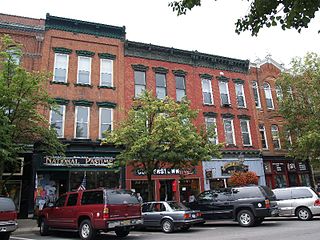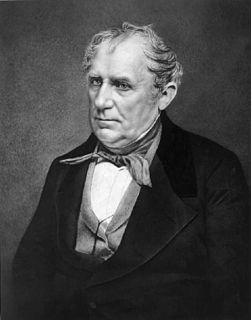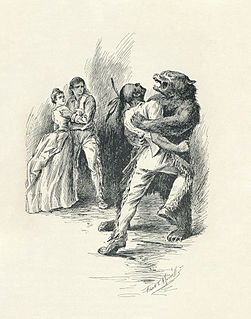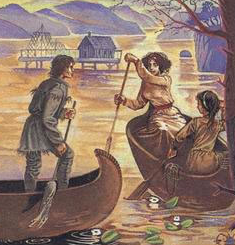Seneca Lake is the largest of the glacial Finger Lakes of the U.S. state of New York, and the deepest glacial lake entirely within the state. It is promoted as being the lake trout capital of the world, and is host of the National Lake Trout Derby. Because of its depth and relative ease of access, the US Navy uses Seneca Lake to perform test and evaluation of equipment ranging from single element transducers to complex sonar arrays and systems. The lake takes its name from the Seneca nation of Native Americans. At the north end of Seneca Lake is the city of Geneva, New York, home of Hobart and William Smith Colleges and the New York State Agricultural Experiment Station, a division of Cornell University. At the south end of the lake is the village of Watkins Glen, New York, famed for auto racing and waterfalls.

The Wandering Jew is a mythical immortal man whose legend began to spread in Europe in the 13th century. In the original legend, a Jew who taunted Jesus on the way to the Crucifixion was then cursed to walk the Earth until the Second Coming. The exact nature of the wanderer's indiscretion varies in different versions of the tale, as do aspects of his character; sometimes he is said to be a shoemaker or other tradesman, while sometimes he is the doorman at the estate of Pontius Pilate.

Auburn is a city in Cayuga County, New York, United States, at the north end of Owasco Lake, one of the Finger Lakes, in Central New York. At the 2020 Census, the population was 26,866. It is the largest city of Cayuga County, the county seat, and the site of the maximum-security Auburn Correctional Facility, as well as the William H. Seward House Museum and the house of abolitionist Harriet Tubman.

Cooperstown is a village in and county seat of Otsego County, New York, United States. Most of the village lies within the town of Otsego, but some of the eastern part is in the town of Middlefield. Located at the foot of Otsego Lake in the Central New York Region, Cooperstown is approximately 60 miles southwest of Albany, 67 mi (108 km) southeast of Syracuse and 145 mi (233 km) northwest of New York City. The population of the village was 1,852 as of the 2010 census.

James Fenimore Cooper was an American writer of the first half of the 19th century, whose historical romances depicting colonist and Indigenous characters from the 17th to the 19th centuries brought him fame and fortune. He lived much of his boyhood and the last fifteen years of life in Cooperstown, New York, which was founded by his father William Cooper on property that he owned. Cooper became a member of the Episcopal Church shortly before his death and contributed generously to it. He attended Yale University for three years, where he was a member of the Linonian Society.

The 1779 Sullivan Expedition was a United States military campaign during the American Revolutionary War, lasting from June to October 1779, against Loyalists and the four British allied Nations of the Iroquois. The campaign was ordered by George Washington, in response to the 1778 Iroquois–British attacks on Wyoming, German Flatts and Cherry Valley, with the aim of "taking the war home to the enemy to break their morale". The Continental Army carried out a scorched-earth campaign, chiefly in the lands of the Iroquois Confederacy in what is now Pennsylvania and western New York state.

The Last of the Mohicans: A Narrative of 1757 is a historical romance written by James Fenimore Cooper in 1826.

Ely Samuel Parker, born Hasanoanda, later known as Donehogawa, was a U.S. Army officer, engineer, and tribal diplomat. He was bilingual, speaking both Seneca and English, and became friends with Lewis Henry Morgan, who became a student of the Iroquois in upstate New York. Parker earned an engineering degree in college and worked on the Erie Canal, among other projects.

A demagogue or rabble-rouser is a political leader in a democracy who gains popularity by arousing the common people against elites, especially through oratory that whips up the passions of crowds, appealing to emotion by scapegoating out-groups, exaggerating dangers to stoke fears, lying for emotional effect, or other rhetoric that tends to drown out reasoned deliberation and encourage fanatical popularity. Demagogues overturn established norms of political conduct, or promise or threaten to do so.

William Cooper was an American merchant, land speculator and developer, the founder of Cooperstown, New York. A politician, he was appointed as a county judge and later served two terms in the United States Congress, representing Otsego County and central New York. He was the father of James Fenimore Cooper, who became a noted writer of historical novels related to the New York frontier.

Major General James Clinton was an American Revolutionary War officer who, with John Sullivan, led in 1779 the Sullivan Expedition in what is now western New York to attack British-allied Seneca and other Iroquois villages. They destroyed 40 villages, as well as their winter stores of wheat and other produce. He obtained the rank of brevet major general.

The Leatherstocking Tales is a series of five novels by American writer James Fenimore Cooper, set in the eighteenth-century era of development in the primarily former Iroquois areas in central New York. Each novel features Natty Bumppo, a frontiersman known to European-American settlers as "Leatherstocking", "The Pathfinder", and "the trapper". Native Americans call him "Deerslayer", "La Longue Carabine", and "Hawkeye".

Chingachgook is a fictional character in four of James Fenimore Cooper's five Leatherstocking Tales, including his 1826 novel The Last of the Mohicans. Chingachgook was a lone Mohican chief and companion of the series' hero, Natty Bumppo. In The Deerslayer, Chingachgook married Wah-ta-Wah, who bore him a son named Uncas, but died while she was still young. Uncas, who was at his birth "last of the Mohicans", grew to manhood but was killed in a battle with the Huron warrior Magua. Chingachgook died as an old man in the novel The Pioneers, which makes him the actual "last of the Mohicans," having outlived his son.

The Boyd and Parker ambush was a minor military engagement in Groveland, New York on September 13, 1779, during the American Revolutionary War. A scout group of the Sullivan Expedition was ambushed and captured by Loyalists and their Seneca Indian allies led by Little Beard.
A skyquake is a phenomenon where a loud booming sound is reported to originate from the sky. The sound may cause noticeable vibration in a building or across a particular area. Those who experience skyquakes typically do not have a clear explanation for what caused them and they are perceived as "mysterious".

Constance Fenimore Woolson was an American novelist, poet, and short story writer. She was a grandniece of James Fenimore Cooper, and is best known for fictions about the Great Lakes region, the American South, and American expatriates in Europe.

Nathaniel "Natty" Bumppo is a fictional character and the protagonist of James Fenimore Cooper's pentalogy of novels known as the Leatherstocking Tales.
Paul Fenimore Cooper was an American writer of children's books and non-fiction, some based on his travels. His first book was a translation of Albanian folk tales.

The American Democrat: Or, Hints on the Social and Civic Relations of the United States of America, a political essay written by American republican author James Fenimore Cooper, was published initially in New York State in 1838. Originally intended as a textbook on the American republican democracy, the work analyzes the social forces that shape, and can ultimately corrupt such a system.

Paul Fenimore Clark was a politician in the American state of Nebraska.

















